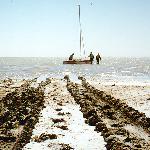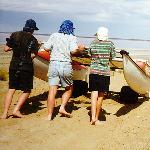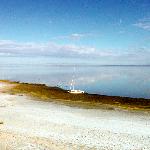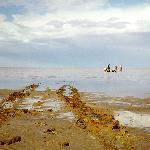
"The biggest barrier to success..."
 |
The Launching Ramp
"The biggest barrier to success..." |
Launching/retrieving your boat is by far the most endurance testing aspect of a Lake Eyre sailing adventure. The Lake profile ensures that a launching ramp of around 1km is the norm for tides less than 2m. Unfortunately Lake access points, while not being in the worst places, provide challenging launching ramps. Fortunately the Lake provides better landing places once you have left home base. These landing places are generally inaccessible by vehicle - you can't have everything.
 Of this launching ramp the first 100m will be loose coarse sand, the Lake perimeter dune normally 3-4m high - but looking much higher. It is best to use beach rollers over this dune unless you are at a "ramp" site such as at ABC Point where the dune has been graded and easily crossed by 4WD vehicles towing a trailer.
Of this launching ramp the first 100m will be loose coarse sand, the Lake perimeter dune normally 3-4m high - but looking much higher. It is best to use beach rollers over this dune unless you are at a "ramp" site such as at ABC Point where the dune has been graded and easily crossed by 4WD vehicles towing a trailer.
The dune ends at the "high tide mark" usually marked by a border of small bushes growing above the salt water table. The next stretch of "beach", often 10-50m of sandy/muddy/gravelly appearance, is drivable if dry - no recent rain.
 The following 100-500m to the water, often covered with salt crystals, is part of the Lake bottom. It should NOT BE DRIVEN ON under any circumstances. Use your boat roller, it will be enough trouble in the mud! Of course some idiot will always try to drive on the Lake surface and spend a day getting back out. While the surface often appears firm, sometimes even sandy under foot, it typically has 150mm of smelly black ooze just under the surface waiting like your worst nightmare - Curdimurka?
The following 100-500m to the water, often covered with salt crystals, is part of the Lake bottom. It should NOT BE DRIVEN ON under any circumstances. Use your boat roller, it will be enough trouble in the mud! Of course some idiot will always try to drive on the Lake surface and spend a day getting back out. While the surface often appears firm, sometimes even sandy under foot, it typically has 150mm of smelly black ooze just under the surface waiting like your worst nightmare - Curdimurka?
 Once in the water the mud becomes firmer under foot and the roller will move more freely. You will have to roll another 100m or so before the boat can be dragged, partially floating, into deeper water.
Once in the water the mud becomes firmer under foot and the roller will move more freely. You will have to roll another 100m or so before the boat can be dragged, partially floating, into deeper water.
Once the craft is floating loading commences. Make sure the boat is moved into deeper water as the loading is done otherwise it sinks into the mud and releasing the "stiction" is nigh impossible. The same "move and load" principle is used for passengers until deep enough water, around 1km from the vehicle, allows the the last poor sole on board and the craft is under way.
Retrieving is the opposite with the added pleasure of being able to drag your craft closer as it's unloaded.
Loading is better performed with wet and dry loaders. The tougher (craziest?) members of the party tolerating the hours of salt water immersion. An interchange tarp is laid at the edge of the dry part of the beach with carefull regard to wind tides.